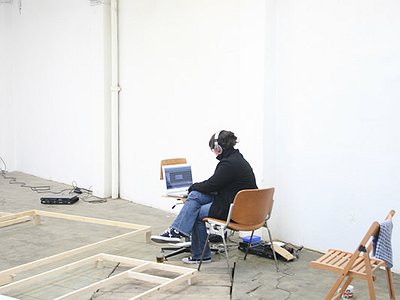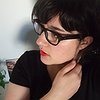Capturing the silence
The relationship between music and other forms of art – painting, video art and cinema most importantly - has become increasingly important. How do you see this relationship yourself and in how far, do you feel, does music relate to other senses than hearing alone?
Music has maintained a close relationship with the other arts, because it is not only happening in time, but also in space. I think the development of sensory skills is often underestimated in the ways of perception in music and art, and in education particular. We are often unaware of the way in which senses collaborate to evoke a thought, an action, and an emotion. Art students who study painting can be totally unaware of the importance of hearing in the construction of a painting. I think we must raise more awareness of the constant shifts taking place between senses in the perceptual experience of sound.
There seem to be two fundamental tendencies in music today: On the one hand, a move towards complete virtualisation, where tracks and albums are merely released as digital files. And, on the other, an even closer union between music, artwork, packaging and physical presentation. Where do you stand between these poles?
The invisible and ‘immaterial’ quality of sound and music is fascinating to me. For thousands of years we were not able to capture or record sound. Before the invention of the electrical medium it was not possible to make an analysis of a specific singular sound, because nature can’t create an exact duplicate of a sound. Before the invention of recording equipment and wave generators sound was natural and unique. Now we think we can capture sounds, but I think a recording is in most cases a two-dimensional impression of a sonic event, because we lose most of the ‘spatiality’ of sound.
Releasing a CD is for me still a very important part of the sound work because it is a way of finalising a work. For many years I have collaborated with graphic designer and ‘administrator’ Allon Kaye from the British label Entr’acte, who often uses vacuum packages. The idea behind these releases is creating a very straightforward way of putting music in the world with necessary information. In the beginning my music is only in a digital format. In collaboration with Jacques Beloeil (mastering) Allon and I will have long conversations about the duration of the work, order of the compositions, sound carrier (cassette, CD or vinyl), typography & typesetting, etc. In the end the music might be a vacuum packed object which has to be destroyed in order to access the work or a vinyl which has a cover with a cryptic message.
The role of an artist is always subject to change. What's your view on the (e.g. political/social/creative) tasks of artists today and how do you try to meet these goals in your work?
When I started composing my music, I worked most of the time in a small room with my own rules and some simple devices. No concerts, no record labels, no critics, no money. It was an interesting time, because I had nothing to lose, only a dream to gain. I was trying to correlate myself to the world, looking for a unique sonic image. As an artist you are not isolated, but you are an active member of the ‘umwelt’.
Music-sharing sites and -blogs as well as a flood of releases in general are presenting both listeners and artists with challenging questions. What's your view on the value of music today? In what way does the abundance of music change our perception of it?
Accessing music through a digital platform has become very easy, but music is not confined to this platform only. Musicians are travellers, not only transmitting their sounds from one location, but generating site-specific sonic events. Two years ago there was a big John Cage happening in ‘Handelsbeurs’, a local concert hall in Gent and I was very happy to see how many people were willing to leave their house on a weekday to experience live the sounds of a cactus.
How, would you say, could non-mainstream forms of music reach wider audiences?
It is great that we can share and exchange our views, images and sounds. The amount of music is sometimes overwhelming and I have less time to find my way through this mass of sound. I think the radio in Belgium, especially the program ‘Laika’, is a great platform to encounter new artists and works. Also my friends, colleagues and students are very helpful in this search.
Since 2003 I work as a teacher at an art academy, introducing to students experimental, contemporary and ‘difficult’ music. The students are most of the time open to different music and are always willing to share their musical background. It has been a real pleasure to constructively work on creating a wider audience. I think it is essential to give young people enough time, space and possibilities to explore and develop their own music.
Usually, it is considered that it is the job of the artist to win over an audience. But listening is also an active, rather than just a passive process. How do you see the role of the listener in the musical communication process?
In the auditory process, sound lies in the center of communication. It is both the ending of a vibrating body and the primary source for the listener to unravel the auditory information. As an artist I try not literally to impose thoughts on the listener, but I express my thoughts through sounds. I see myself as an artist who invites someone to come over, sit down and listen. Of course this is an open invitation…
Reaching audiences usually involves reaching out to the press and possibly working with a PR company. What's your perspective on the promo system? In which way do music journalism and PR companies change the way music is perceived by the public?
I have no experiences with PR companies and unfortunately there are not so many music journalists writing about experimental and contemporary music. I was fortunate enough that some journalists picked up my music and sound works and were willing to listen and experience it. A review or a publication, but also collaboration with a visual artist or architect can help to bring a work to a new audience.
Please recommend two artists to our readers which you feel deserve their attention.
Wu Na - a Chinese guqin player, living and working in Beijing
Rie Nakajima - a Japanese sound artist , living and working in London
Read more about Esther Venrooy and her projects on www.esthervenrooy.net






